- EBMS Knowledge Base
- Financials
- Financial Reporting
-
Client Resources
-
EBMS Main Documentation
- Introduction
- Getting Started
- Getting Started | Initial Installation
- Getting Started | Company Setup
- Quick User Guide | Financial Staff | Accountant
- Quick User Guide | Financial Staff | Accountant | Accountants Journal
- Quick User Guide | Sales Staff
- Quick User Guide | General Staff
- Features
- Reports
- Security
- Server Manager
- Technical
- Technical | Data Import and Export Utility
- Technical | SQL Mirror
- Automotive
- Automotive | Parts Catalog
- Automotive | Pricing
- Automotive | Point of Sale
- Automotive | Product Application
- Automotive | Keystone Interface
- Metal Supply
- Fuel Sales
- Horticulture
- Horticulture | Farm Setup
- Horticulture | Processing Payroll
- Horticulture | Managing the Farm
-
Sales
- Introduction
- Customers
- Customers | Miscellaneous Customers
- Proposals
- Proposals | Processing Proposals
- Proposals | Sets and Templates
- MyProposals
- MyOrders
- Sales Orders
- Invoices
- Materials Lists
- Sales and Use Tax
- Sales and Use Tax | TaxJar
- CRM
- CRM | Auto Send
- Recurring Billing
- Credits
- Customer Payments
- Payment Card Processing
- Payment Card Processing | Gift Cards
- Payment Card Processing | Loyalty Cards
- Payment Card Processing | Verifone Gateway
- Freight and Shipping Tools
- General Ledger Transactions
- Point of Sale
- Point of Sale | Point of Sale Hardware
- Point of Sale | Xpress POS System
- Point of Sale | Advanced Tools
- Signature Capture
- Salesperson Commissions
-
Inventory
- Product Catalog
- Product Catalog | Using Product Codes for No Count Items
- Product Pricing
- Product Pricing | Special Pricing
- Tracking Counts
- Unit of Measure
- Purchasing
- Special Orders and Drop Shipped Items
- Receiving Product
- Barcodes
- MyInventory and Scanner
- Components (BOM) and Accessories
- Components (BOM) and Accessories | Component Formula Tool
- Made-to-Order Kitting
- Configure-to-Order Kitting
- Multiple Inventory Locations
- Multiple Inventory Locations | Creating Locations
- Multiple Inventory Locations | Using Multiple Locations
- Multiple Inventory Locations | Product Catalog Sync
- Multi-Vendor Catalog
- Serialized Items
- Serialized Items | Purchasing or Manufacturing an Item
- Serialized Items | Selling and/or Associating an item with a customer
- Lots
- Product Attributes
- Product Attributes | Selling and Purchasing Items with Attributes
- Product Attributes | Custom Attributes
- Mobile Scanner (Legacy)
-
Labor
- Getting Started
- Workers
- Taxes and Deductions
- Work Codes
- Time and Attendance
- Time and Attendance | Time Track App
- Processing Payroll
- Closing the Payroll Year
- Processing Payroll - Advanced
- Salaried Pay
- Piecework Pay
- Direct Deposit
- 3rd Party Payroll Service
- Subcontract Workers
- Flag Pay
- Prevailing Wages
- MyDispatch
- MyTasks
- MyTime
- MyTime | Communications
- MyTime | Setup
- Tasks
- Tasks | Getting Started
- Tasks | Creating Tasks
- Tasks | Scheduling Tasks
- Tasks | Customizing Task Views
- Tasks | Managing Tasks
-
Financials
- Introduction
- Fiscal Year
- Chart of Accounts
- Budget
- Financial Reporting
- Transactions and Journals
- Transactions and Journals | Journals
- Account Reconciliation
- 1099
- Departments and Profit Centers
- Fund Accounts
- Bank Accounts
- Bank Feed
- Vendors
- Vendors | Miscellaneous Vendors
- Purchase Orders
- Expense Invoices
- Vendor Payments
- AP Transactions
- Landed Cost
- Fixed Assets and Depreciation
- Fixed Assets and Depreciation | Fixed Assets
- Fixed Assets and Depreciation | Fixed Assets | Adding Assets
- Fixed Assets and Depreciation | Processing Depreciation
- Fixed Assets and Depreciation | Disposing Assets
- MyJobs
-
E-commerce
-
Rental
-
Job Costing
-
Manufacturing
Profit and Loss/Income Statement
Where to find P&L Reports and Income Summaries
The Profit and Loss (P&L) statement is a financial statement that summarizes the revenue, cost of goods sold (COGS), administrative expenses, and overhead incurred during a specified period. The P&L statement is the same as an income statement. These reports report the profits or losses during the reporting periods including both the total revenue (A), gross profit (C), and net profit (D).
Review the example report below for example profit values. The profitability of a company, department, or profit center is determined using a profit and loss statement. The variety of P&L statements included in EBMS allow the user to compare monthly, quarterly, or annual profits for a given profit center. These important reports will give a manager the tools required to make management decisions based on profit trends for a given time period or profit center.
The financial account grouping and labels are determined by the configuration of the chart of accounts. Review Chart of Accounts Folders for more details on configuration of groups or changing labels.
Monthly Profit & Loss Detail
This popular P&L report is used to evaluate both the monthly and year-to-date profit summaries. To access this report, go to File > Reports > Financials > Profit & Loss > Standard P&L > Monthly Profit & Loss Detail.
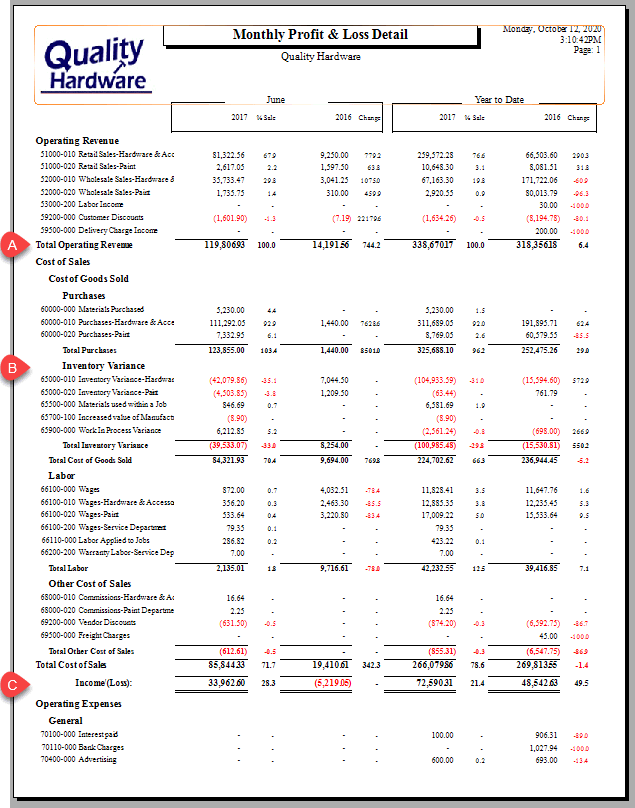
Section A. Total Operating Revenue: Total revenue for the given period. Note that miscellaneous income (E) may appear at the end of the report as non-operating revenue.
Section B. Inventory Variance: The inventory variance section is used to adjust the purchase totals to calculate the total cost of goods sold. This section can be eliminated by combining the inventory value change with the total purchases. Review Inventory Variance for more details on this optional section within the profit and loss statement.
Sections C and D. Income (Loss): The Income (Loss) line following the cost of sales section identifies the gross profit of the company or profit center. This important value reports profits without the administrative or overhead costs.
Section E. The net profit is displayed at the end of the P&L statement includes the company expenses to report a complete profit picture within the given time period. See the following example of the last page of the profit and loss statement.
Last page of the same report: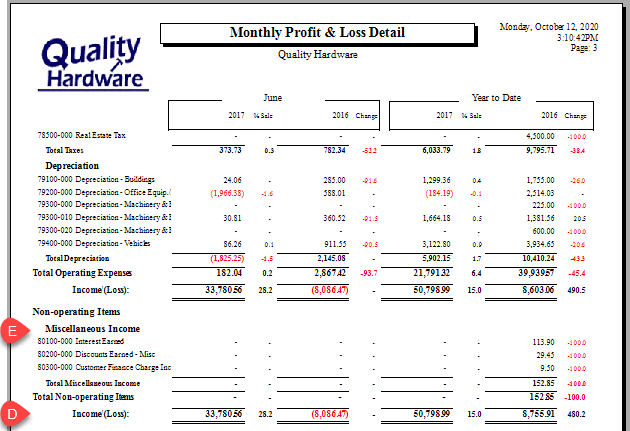
Annual Profit & Loss 8 Year Comparison
Most P&L statements contain multiple period comparisons. Find profit and loss reports by selecting File > Reports from the main EBMS menu and then opening Financials > Profit & Loss as shown below:
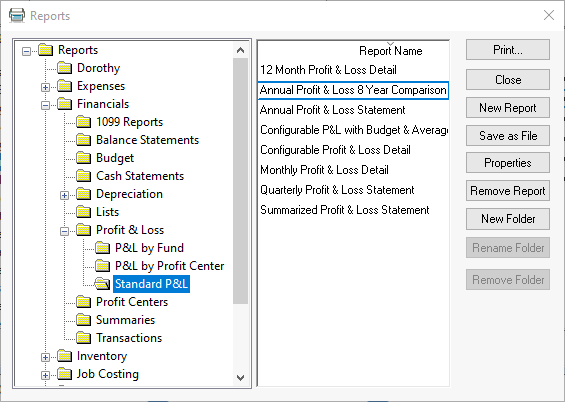
- The Standard P&L group is the most common group of reports.
- The P&L by Fund group is designed for nonprofit organizations. Review the following section for profit center P&L option details.
- The P&L by Profit Center group only includes profit and loss reports for profit centers, company divisions, or departments.
The Annual Profit & Loss 8 Year Comparison report is useful to review trends over multiple years.
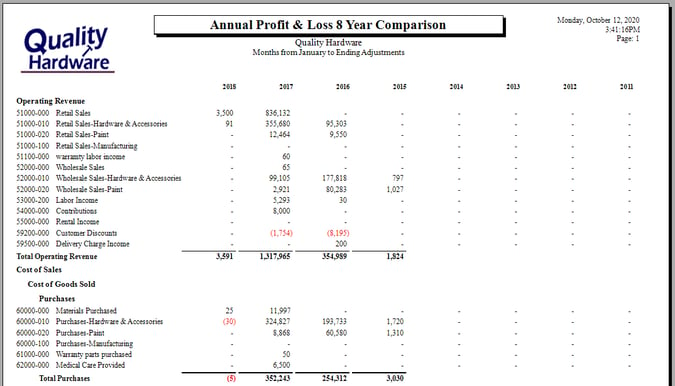
P&L by Profit Center
An effective way to evaluate profits within a company is to generate profit and loss reports per profit center, division, or department. Open these reports by selecting File > Reports from the main EBMS menu and then selecting Financials > Profit & Loss > P&L by Profit Center as shown below:
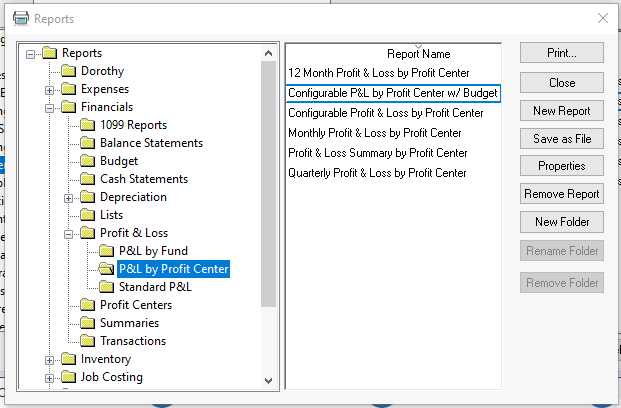
The Configurable P&L by Proft Center w/ Budget & Avg report contains various columns and allows the user to custom define the monthly range period.
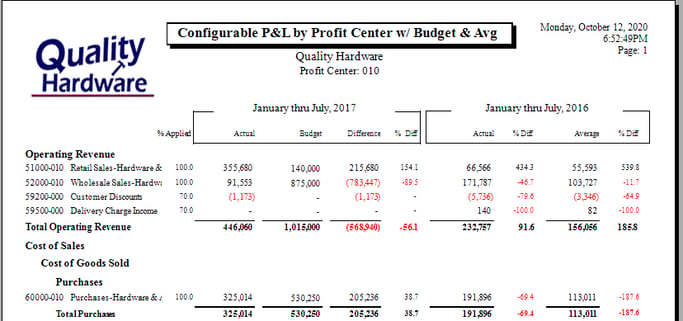
The Profit & Loss Summary by Profit Center is a great report for a simple summary of the profits for each profit center.

